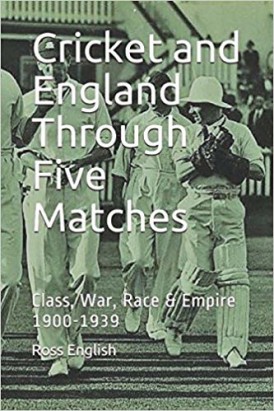Cricket and England Through Five Matches
Martin Chandler |Published: 2018
Pages: 254
Author: English, Ross
Publisher: English, Ross
Rating: 3.5 stars

Publishers have their uses, and almost every self-published book I have ever read highlights what those are. They also have their drawbacks, the main one of which, perhaps understandable given that a need to turn a profit exists in any commercial organisation, seems to be a reluctance to take risks with the content of their output. Cricket and England Through Five Matches demonstrates both rather well. I know not whether Ross English sought a publisher, but had he done so and found one that was interested I rather doubt they would have allowed him to publish in the way he wanted to, and that in tweaking the narrative to appeal to a wider market much that is good would have been lost.
On the other hand a publisher would doubtless have made sure that the main failing of the book, not that it is a terribly serious one, would have been avoided. I can well imagine why there is no photographic section in the book, but that is the more frustrating because of how impressive the two that are present are. The shot that adorns the front and rear cover certainly deserves an introduction, and the only one reproduced in the text, culled from the Daily Mail at the end of August 1914, is a particularly meaningful one.
English is by no means the first to have used cricket as a vehicle to explain social history, but despite the number of others who have attempted to do so I do not recall enjoying such a book as much before. Of particular interest is the Middlesex v Kent match in 1914, the last First Class cricket played at Lord’s before the game closed down for the Great War, and that Daily Mail photograph. There is no cricket in the image, rather it is a picture of men in the crowd, the point of the shot being to enable the newspaper’s editor to rail against those who chose to watch cricket rather than wage war.
The first of the five matches is the Gentlemen v Players fixture at Lord’s in 1900, so the end of Victorian England and the height of cricket’s ‘golden age’. Enjoyable though that is that 1914 fixture, and the one that follows it, the Headingley Test between England and South Africa in 1924, are rather more interesting. Any match in which England shoot out the opposition for 30 is worth reading about, but the real interest lies in the background to that encounter and the way in which the game had to pick itself up and re-establish itself after the return of peace. Most of what English describes I was aware of, but had never really strung it all together before, and to have those previously disparate pieces of knowledge seamlessly strung together is something I will remain grateful for.
From 1924 Cricket and England Through Five Matches takes in England’s defeat in what was then British Guiana in 1930. This is another valuable exercise. The four match series was drawn 1-1 by an England side who seemed to see themselves almost as missionaries. There was plenty of interesting cricket played yet almost nothing was published on the subject of the tour at the time, and precious little has appeared since. After many hours of research amongst contemporary Caribbean newspapers English does a decent job of breathing life into his account of the play, and as importantly examines the inevitable tensions that developed. In particular the Englishmen did not like the way Learie Constantine bumped the ball down at them in the early matches. Small wonder therefore that Constantine had no qualms about using Jardinian leg theory three years late in the aftermath of the ‘Bodyline’ tour.
The final match of the five harks back to match number two, looking at one of the last round of Championship matches of the 1939 season. Hove was the venue and Yorkshire were visiting the south coast. Champions again, Yorkshire won by nine wickets, and although no one knew it at the time the game bade farewell to Hedley Verity. His last act in First Class cricket was to open the bowling on a ground generally remembered more for the deeds of pace bowlers than spinners. He only bowled six overs, but in them took 7-9. It might have been more impressive, but Sussex opening bat Bob Stainton wasn’t fit to bat, and the last man was run out without, as they say, troubling the scorers.
There is no real point in picking up Cricket and England Through Five Matches unless the reader is genuinely interested in both the cricketing aspects of the book and the social history. In many cricket books the social history is incidental to the cricket content, but that observation cannot be made here. For this reviewer English is probably at his best in analysing the changes in English society in the inter-war period that amounts to his introduction to that Sussex and Yorkshire game and, in relation to the purely cricketing aspect, on that rarely chronicled trip to the Caribbean in 1930.






Leave a comment